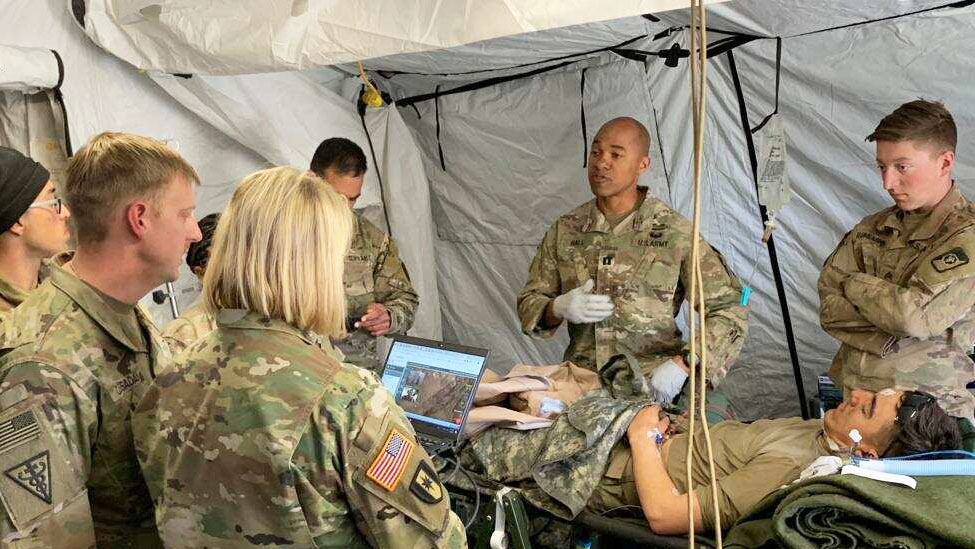
ON THE LOOKOUT: “We’re looking for breakthrough innovations, and we’re trying to create category-leading companies,” said ARCH’s Ritter. (Getty Images/Avalon_Studio)
USAMRDC’s new partnership works to find and fund future technology.
by Ramin A. Khalili
For Corey Ritter, it’s almost like a homecoming of sorts—a chance to fuse the past and present. Sitting in his office in northwest Chicago, in a building just a few miles west of Lake Michigan, Ritter can not only see what the future of military medicine looks like—he is, in fact, one of a select group of people helping to directly shape that future via a new initiative to partner federal agencies with cutting-edge private companies.
“I was an Army brat as a kid and then, later, an infantry officer for eight years,” said Ritter, a veteran who was deployed twice between 2010 and 2013, before transitioning to the private sector in 2016. “In Afghanistan I saw, in action, the health care technologies that were saving lives.” That experience is now playing a major role in the future of the U.S. Army Medical Research and Development Command (USAMRDC)—an entity that serves as the Army’s medical materiel developer and, also, further maintains responsibility for medical research, development and acquisition. As an associate with ARCH Venture Partners—a global venture capital firm that both creates and provides investments for new companies focused on physical and life-sciences research—Ritter and the larger ARCH team are spearheading a new internal program dedicated to spotting ascendant scientific technologies for the firm’s corporate partners. A result of that effort, USAMRDC is now partnering with ARCH to identify new and potentially game-changing medical devices and treatments for U.S. warfighters. For USAMRDC, it’s the first-ever foray into such a pairing; and as such holds substantial—and as yet untapped—potential.
“We’re looking for breakthrough innovations, and we’re trying to create category-leading companies,” said Ritter, noting that ARCH’s myriad funding efforts—worth $4.5 billion total—have helped start more than 250 companies since the firm’s inception 35 years ago. “We’re looking for companies that have a significantly better solution to an important problem, who then go on to lead that category.”

IN DEPTH: Medical personnel from Regional Health Command – Pacific use virtual health capabilities to treat a simulated patient during Joint Warfighting Assessment April 23 to May 10 in Yakima, Washington. ARCH provides more in-depth examinations of those chosen technologies for USAMRDC leaders. (Photo by Flavia Hulsey, Regional Health Command – Pacific)
A NEW VENTURE
The USAMRDC partnership with venture capital companies is still a burgeoning effort—the pairing with ARCH is less than a year old—but, on a larger scale, it represents the command’s desire to quickly find, fund and procure the types of technologies required to keep U.S. Soldiers safe on the seemingly ever-changing battlefield of the future; a place defined as much by potential location as by the technology (and the technological knowhow) of a given adversary. Such corporate efforts are chiefly routed through the Medical Technology Enterprise Consortium (MTEC), a powerful USAMRDC partner that aims to accelerate the development of revolutionary medical solutions to meet the needs of U.S. military personnel and veterans. In a unique way—and in an almost parallel manner—MTEC has a reach that rivals ARCH’s own.
For Jill Sorensen, the chief operating officer for MTEC, focusing on such a vast array of military medical requirements, especially in an era of fast-moving technological landscapes, requires near-constant, round-the-clock attention. “We’re living in the realm of the unmet medical need, [and] so the question is—how do we accelerate filling that gap?” said Sorensen, noting the contemporary need to identify both immediate and potential medical concerns, and their accompanying solutions, as quickly as possible. “A term that we’ve been using to explain this is ‘readiness,’ or in this context, ‘commercial readiness.’ ”
SHARED VISION
That MTEC’s own priorities would align so cleanly with the USAMRDC’s (i.e., a keen focus on Soldier readiness) is to be expected. A nonprofit corporation comprising a vast stable of private, academic and not-for-profit organizations, MTEC is a 501(c)(3) biomedical technology consortium collaborating with USAMRDC under an other-transaction authority agreement, a mechanism that allows consortium members and government program managers to hold open discussions throughout the solicitation phase. That capability, in turn, enables the rapid exchange of information among government entities, private technology developers and funding partners, which ultimately facilitates partnerships and paves the way for innovation. At the end of 2020, MTEC boasted a roster of more than 460 such members. Simply put, once they get their hands around a prototype-ready innovation, MTEC members have the connections required to bring that product to market.
What makes this partnership so unique, however, is the manner in which these ideas are submitted to MTEC in the first place. In short, ARCH performs what can be described as “technology scouting.” Using its decadeslong involvement and familiarity in the worlds of oncology, infectious diseases and gene sequencing (among other areas) to provide potential candidates for review. To employ a simple sports analogy, Ritter and the team at ARCH act as high-tech baseball scouts—industry veterans charged with spotting up-and-coming young players who are then, in turn, nurtured and coached with the hope of future success. It’s a unique comparison, but one that Sorensen doesn’t shy away from.
“They say this work is a contact sport because you need to see the detail—and so I think it’s a fair analogy,” she said. “We describe technology and teams as important components of success.”
“We’re helping USAMRDC and MTEC with finding new opportunities and evaluating technical landscapes, and then evaluating the entrepreneurial activity in those areas,” she explained.

SCOUTING REPORT: Like a scout in baseball, the team at ARCH looks for up-and-coming medical technologies that are then nurtured and coached with the hopes they’ll one day be ready for the big leagues. (Getty Images)
GAME CHANGERS
ARCH certainly knows the territory well. The firm has a decadeslong track record of searching for up-and-coming technological innovations at places like universities and national labs; efforts that inexorably paved the way for key personal connections and additional partnerships. It’s this kind of ear-to-the-ground approach that helped ARCH identify and invest in then-nascent California-based Illumina Inc. in the late 1990s. That firm has since achieved notoriety for driving down the cost of human genome sequencing—from hundreds of millions of dollars to, currently, just $1,000 per human genome.
In specific terms, the technology scouting process as it pertains to USAMRDC is relatively simple. First, ARCH provides a series of monthly updates—or, to continue the previous sports analogy, “scouting reports”—to the MTEC team. “They have multiple sets of eyes and ears,” Sorensen said of ARCH’s value in this first step alone. Those monthly reports notably stretch across a number of key interest areas, covering topics pertinent to each individual USAMRDC Joint Program Committee—topics like trauma care and infectious disease, among others.
The reports are shared with USAMRDC leadership, who pick the specific technologies or concepts they’d like to pursue. ARCH then stands ready to provide deeper, more in-depth looks at those chosen technologies before leaders make their final decisions. In fact, they’ve recently provided USAMRDC leaders with in-depth reports on new technologies designed to combat COVID-19. Finally, once a choice has been made, the MTEC team, led by Research Program Director Dr. Lauren Palestrini, begins the process of pairing the creators of the chosen technology with one (or two or three, if needed) of MTEC’s many partner organizations to help guide that fledgling technological innovation to market. Procurement for military use then naturally follows.
“We want to get to the finish line, which is production,” said Sorensen, noting that the process is constantly being refined for efficiency. “And that involves a lot of elements, a lot of discipline. ARCH’s capabilities augment and accelerate our commercialization efforts beyond military funding to enhance investments by all stakeholders.”
A DISCIPLINED APPROACH
If anyone is familiar with that kind of discipline, it’s Ritter. He noted that, of the thousands of companies and product ideas that the ARCH team sees each year, the firm only makes about 10 to 15 investments. That kind of discerning eye can only be a boon to the people and infrastructure tasked with protecting U.S. Soldiers from a number of encroaching threats. “We think there’s a good overlap between the kinds of companies we’re working with and Department of Defense needs regarding traumatic brain injury, post-traumatic stress and the optimization of human performance,” Ritter said.
Regardless of the need or interest area—and given USAMRDC’s wide and global footprint, there are a good many—the partnership with an outside firm like ARCH has, itself, become the kind of game-changing force the command is routinely looking for in products and therapeutics. “We’re excited to partner with venture capital and try something new,” said Sara Langdon, USAMRDC program manager for other-transaction authority agreements with MTEC. “We aim to leverage, through MTEC, the expertise and infrastructure of ARCH to support current and future partnerships in the commercial space.”

LEADING THE PACK: Soldiers assigned to the Womack Army Medical Center warehouse at Fort Bragg, North Carolina, prepare crates of supplies to support the COVID-19 testing site on the installation. USAMRDC and ARCH are teaming up to identify new and potentially game-changing medical devices and treatments for U.S. warfighters. (Photo by Twana Atkinson, Womack Army Medical Center)
CONCLUSION
As for the fruits of all that labor—the physical products and technologies themselves—Sorensen said (with a notable degree of excitement) that MTEC and USAMRDC will be releasing updates in the coming months; a real achievement, given that the partnership between MTEC and ARCH is still relatively young. Meanwhile, MTEC will continue to work with other venture capital firms as well (“a small handful of firms,” in Sorensen’s words). Additionally, and as a testament to MTEC’s enduring efforts to reach as far into the corporate world as possible, the organization is creating a new Venture Corps; a sub-entity designed to specifically advance conversations with former military personnel in the investment arena who—like Ritter, for example—understand the importance of the military medical mission.
“We think those engagements with the private markets are mission critical,” Sorensen said. “We think that they’ll be a true measure of our service to the military and the warfighter, and [also] our service to our members.”
That brings the spotlight back to Ritter, who has found a way to continue his Army service well after hanging up his uniform. For him, it’s a familiar path to walk—and yet, at the same time, it covers some new and interesting terrain. “For me personally, it’s been really great to start this partnership with MRDC and to help them find new technologies that can make a difference,” he said. “Any connections we can make are great for us as a firm, but it’s also personally satisfying.”
For more information about the USAMRDC, go to https://mrdc.amedd.army.mil/. To learn more about MTEC, go to https://www.mtec-sc.org/.
RAMIN KHALILI is a writer with USAMRDC’s Public Affairs Office. Before assuming his current role, he spent five years as the knowledge manager for USAMRDC’s Combat Casualty Care Research Program. During his previous work as a broadcast journalist, he earned an Associated Press Award for his work in Phoenix before serving as chief NASA correspondent for CBS in Orlando, Florida. He holds a B.A. in communications from Penn State University.
Read the full article in the Spring 2021 issue of Army AL&T magazine.
Subscribe to Army AL&T – the premier source of Army acquisition news and information.
![]()







